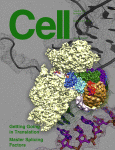法国居里研究院的Théry C是当今胞外囊泡与外泌体研究领域的世界顶级大牛,最新一期的Cell发表了他和Tkach M的一篇综述,2015年胞外囊泡与外泌体以三篇Nature文章引起巨大轰动,相信2016年伊始的这篇Cell文章会继续引航今年胞外囊泡与外泌体研究领域的火热之风!
文献摘要:
在多细胞生物中,远处的细胞可以通过发送由单分子组成的信号交换信息,或者如越来越多的文献例证的那样,通过主动选择的蛋白质、脂质和核酸填充形成的复杂包裹形式进行信号交换,这种包裹性使被称为胞外囊泡(EVs,在其他的命名中也被称为外泌体和微泡)。本文综述了一些描述胞外囊泡分泌最引人注目的功能,还介绍了我们对它们生理作用的极限认知。虽然有初步迹象显示,胞外囊泡调节的通路在体内发挥功能,但参与这些作用的胞外囊泡的天然特性依旧需要被阐明。在本文中,作者们聚焦于肿瘤细胞及其微环境领域,但是相似的结果和挑战同样适用于生理和病理系统,胞外囊泡调节的通讯被认为在这些系统中发生。
In multicellular organisms, distant cells can exchange information by sending out signals composed of single molecules or, as increasingly exemplified in the literature, via complex packets stuffed with a selection of proteins, lipids, and nucleic acids, called extracellular vesicles (EVs; also known as exosomes and microvesicles, among other names). This Review covers some of the most striking functions described for EV secretion but also presents the limitations on our knowledge of their physiological roles. While there are initial indications that EV-mediated pathways operate in vivo, the actual nature of the EVs involved in these effects still needs to be clarified. Here, we focus on the context of tumor cells and their microenvironment, but similar results and challenges apply to all patho/physiological systems in which EV-mediated communication is proposed to take place.





